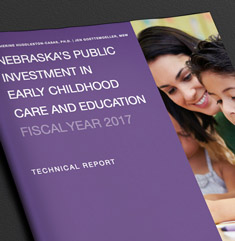
Buffet Early Childhood Institute Reports and Publications
Date of this Version
7-2021
Document Type
Article
Citation
Welch, G.W., Svoboda, E.A., Daro, A., Bryant, V., & Glissmeyer, C. (2021). 2021 Nebraska Child Care Market Rate Survey. University of Nebraska: Buffett Early Childhood Institute.
Abstract
Consistent with the 2019 MRS, the Institute conducted a survey of all licensed child care providers across the state to obtain private pay child care rates for children with or without medical and behavioral needs. Categories of focus for data collection and reporting included: 1. Geographic location: rural or urban 2. Type of care: Family Child Care Home I, Family Child Care Home II, Child Care Center, and School Age License 3. Age group of children: infant, toddler, pre-school, and school-age 4. Status of medical and behavioral needs 5. Accreditation 6. Extent to which child care providers participate in Child Care Subsidy Program 7. Barriers to child care providers accepting the Child Care Subsidy Program 8. Proportion of children who receive subsidy 9. What limits, if any, providers place on the number of children they will accept with the Child Care Subsidy Program 10. What level the provider participates in Nebraska’s Quality Rating and Improvement system, Step Up to Quality (SUTQ), or other systems of quality indicators 11. Cost of implementation required for health and safety trainings 12. Traditional and non-traditional care In addition to conducting the 2021 MRS, the Institute agreed to perform the following services for NDHHS: 1. Analyze data. Executive summary and recommendations presented in a format and file type approved by the Department of Health and Human Services (DHHS), summarizing overall study findings and providing recommendations to lead agencies as mentioned above. Analyses of rates will be presented in hourly and day units reflective of 50th through 100th percentiles in increments of 5. 2. Monthly preliminary data estimates in hourly and day units categorized by geographic location, type of child care provider, and age group of child. 3. Write and deliver a comprehensive report of study process and results. 4. Produce a secondary comprehensive report that calculates rates reflective of halfday/ full-day units and half-week/full-week units. 5. Provide ongoing support, including presentation of study process and findings to stakeholder groups. The methodology utilized to compute rates was consistent with the approach that has been used in other states (e.g., Oregon, Colorado, Michigan) in their recent market rate surveys. This approach is rigorous and, as applied to available data, will yield valid results.
Included in
Child Psychology Commons, Developmental Psychology Commons, Early Childhood Education Commons, Educational Psychology Commons, Educational Sociology Commons, Education Economics Commons, Education Policy Commons, Policy History, Theory, and Methods Commons, Pre-Elementary, Early Childhood, Kindergarten Teacher Education Commons, School Psychology Commons


Comments
Copyright © 2021 Buffett Early Childhood Institute.